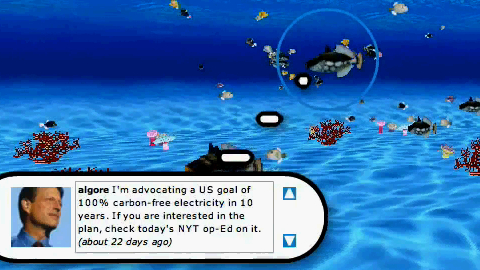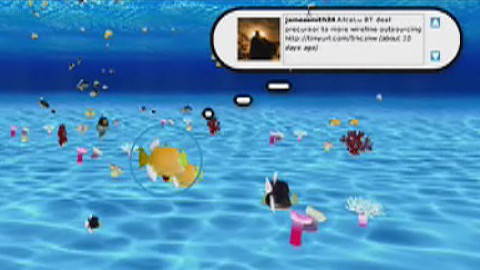Swiss company goes fishing in a sea of tweets

Almost a decade out of political office, Al Gore is still a very big fish: an environmentally conscious, tech-savvy, social networking fish.
Thanks to a Lausanne-based firm, the former United States vice president and Nobel laureate remains in the spotlight – tracked by tens of thousands – as though he were living his life in a big fishbowl.
Most days, he floats around effortlessly, occasionally adjusting his vector with a tail wiggle.
The colourful specimen lives in Minsh, an online world that is the brainchild of computer scientists working on the campus of the Federal Institute of Technology in Lausanne.
Its founders hope it will become the three dimensional, real-time representation of the internet’s collective consciousness.
“Minsh is an underwater virtual world where each fish represents a Twitter user,” says Barbara Yersin, the co-founder of Minsh, in reference to the phenomenally popular micro-blogging platform.
“So here, for instance, you have the fish of Al Gore, who is on Twitter and also on Minsh,” Yersin says. “He doesn’t know it though.”
Schools of thoughts
The big idea is that the social behaviour of fish will represent what people are thinking and talking about online. In the world of Minsh, people writing about any given subject find themselves swimming in the same school.
When a person updates his or her Twitter status, the fish swims away to join people with similar thoughts on their minds. “It’s real time. It’s really based on what’s happening right now,” Yersin told swissinfo.
For those who haven’t yet caught up with Twitter, here are the basics: Twitter is an online service that lets people post updates of a maximum of 140 characters. The updates are called “tweets”.
The service works on the premise that people establish connections with their friends as well as with similarly minded strangers whom they can find through a search. They then receive updates from the others in their network.
Twitter reportedly has between four and five million users. It is a relatively new platform and leaves many people over 40 scratching their heads. Nevertheless, it has already joined the mainstream.
Politicians in North America and Britain use it to try to appear hip, the Israeli defence ministry used it to hold a media conference and journalists use it as a supplement to traditional reporting.
In February, the sequence of an unsuccessful rescue attempt of a British tourist in the Swiss resort of Verbier played out over Twitter.
Fishy business
Yersin says the project intentionally avoided depicting humans in favour of what she calls a “very nice calm environment”.
“Everybody else is doing humans,” she said. “We worked on humans the last four years and noticed that every single human being is a specialist on human beings, right?”
“When you see an animation that is not quite smooth, you lose the feeling of immersion. When you are using fish, it is much simpler.”
The founders of Minsh are targeting Twitter users looking for an extra tool to visualise their network and meet new people. Eventually, they want to apply the service to other social networks. “If you have an account on Twitter and I have an account on Facebook, we can meet in Minsh,” Yersin said.
The service will launch to a select 10,000 users around the middle of April. Yersin says the company has a clear idea of where it wants to go eventually, but is making a modest start.
“We are making a very early launch, meaning that many features we want to develop are not developed yet,” she said. “But we want to put Minsh online as soon as possible to see how the users react, what they want.”
Money business
Social networking firms have not yet worked out how to translate the activity of millions of users into some kind of reliable revenue stream. Facebook, which in 2008 was valued between $3.75 billion (SFr4.29 billion) and $5 billion, earned revenues estimated at $300 million last year.
“I don’t think social networks can be monetised in the same way that search did,” Facebook founder, Mark Zuckerberg, has said. “In three years from now we have to figure out what the optimum model is. But that is not our primary focus today.”
Palo Alto-based Facebook generates its earnings by selling advertisements but as in the case of the dot-com collapse of the late 1990s, entrepreneurs have in many cases overestimated the abilities of their online assets to bring in cash.
Twitter, founded in 2006, sells no advertisements and if it has a viable business plan, is doing a stellar job of keeping it a secret.
By the beginning of 2010, Minsh wants to sell “fun and functional” virtual items like improved fish. Yersin is also mulling over establishing partnerships with environmental organisations to let users buy virtual endangered fish.
But for the time being, the Swiss-based service will be free. “We have a business model, which is completely different from Twitter,” Yersin said.
swissinfo, Justin Häne in Lausanne
The name Minsh is a portmanteau – like “Brangelina” and “brunch”. It combines “mingle” and “fish”.
Minsh runs on Adobe Flash technology.
Fish are grouped based on the subjects of their tweets rather than on personal connections.
Users can also override this function and assign their fish to a particular subject.
Like most basic search engines, Minsh filters out common words like “the” and “have”.
Minsh was founded in the summer of 2007 by Barbara Yersin and Jonathan Maim, two PhD students in the virtual reality laboratory at the Federal Institute of Technology in Lausanne (EPFL).
They are specialists in crowd simulations but were keen to establish a start-up independent of their coursework.
Minsh consists of five people including an art director, a programmer for the front end of Minsh and a scalability specialist.
The company has received grants to pay salaries from Switzerland’s innovation promotion agency and from the EPFL.
Minsh runs on Amazon’s web service, which allows it to add and remove servers according to bandwidth demanded.

In compliance with the JTI standards
More: SWI swissinfo.ch certified by the Journalism Trust Initiative



You can find an overview of ongoing debates with our journalists here. Please join us!
If you want to start a conversation about a topic raised in this article or want to report factual errors, email us at english@swissinfo.ch.